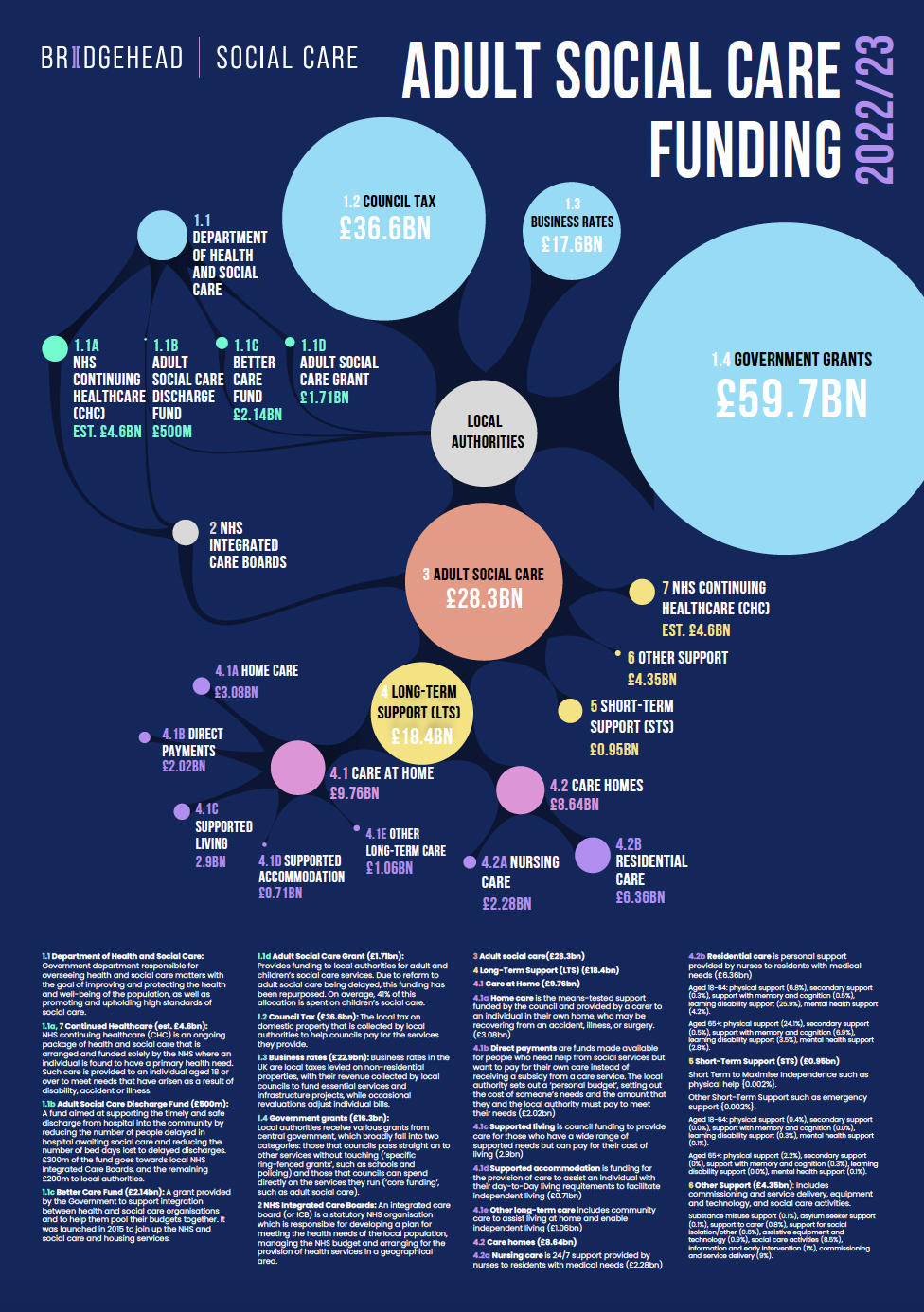
1.1. Department of Health and Social Care: Government department responsible for overseeing health and social care matters with the goal of improving and protecting the health and well-being of the population, as well as promoting and upholding high standards of social care.
1.1a. Continued Healthcare (est. £4.6bn): NHS continuing healthcare (CHC) is an ongoing package of health and social care that is arranged and funded solely by the NHS where an individual is found to have a primary health need. Such care is provided to an individual aged 18 or over to meet needs that have arisen as a result of disability, accident or illness.
1.1b. Adult Social Care Discharge Fund (£500m): A fund aimed at supporting the timely and safe discharge from hospital into the community by reducing the number of people delayed in hospital awaiting social care and reducing the number of bed days lost to delayed discharges. £300m of the fund goes towards local NHS Integrated Care Boards, and the remaining £200m to local authorities.
1.1c. Better Care Fund (£2.14bn): A grant provided by the Government to support integration between health and social care organisations and to help them pool their budgets together. It was launched in 2015 to join up the NHS and social care and housing services.
1.1d. Adult Social Care Grant (£1.71bn): Provides funding to local authorities for adult and children’s social care services. Due to reform to adult social care being delayed, this funding has been repurposed. On average, 41% of this allocation is spent on children’s social care.
1.2 .Council Tax (£36.6bn): The local tax on domestic property that is collected by local authorities to help councils pay for the services they provide.
1.3. Business rates (£22.9bn): Business rates in the UK are local taxes levied on non-residential properties, with their revenue collected by local councils to fund essential services and infrastructure projects, while occasional revaluations adjust individual bills.
1.4. Government grants (£16.3bn): Local authorities receive various grants from central government, which broadly fall into two categories: those that councils pass straight on to other services without touching (‘specific ring-fenced grants’, such as schools and policing) and those that councils can spend directly on the services they run (‘core funding’, such as adult social care).
2. NHS Integrated Care Boards: An integrated care board (or ICB) is a statutory NHS organisation which is responsible for developing a plan for meeting the health needs of the local population, managing the NHS budget and arranging for the provision of health services in a geographical area
3. Adult social care (£28.3bn)
4. Long-Term Support (LTS) (£18.4bn)
4.1. Care at Home (£9.76bn)
4.1a. Home care is the means-tested support funded by the council and provided by a carer to an individual in their own home, who may be recovering from an accident, illness, or surgery. (£3.08bn)
4.1b. Direct payments are funds made available for people who need help from social services but want to pay for their own care instead of receiving a subsidy from a care service. The local authority sets out a ‘personal budget’, setting out the cost of someone’s needs and the amount that they and the local authority must pay to meet their needs (£2.02bn)
4.1c. Supported living is council funding to provide care for those who have a wide range of supported needs but can pay for their cost of living (2.9bn)
4.1d. Supported accommodation is funding for the provision of care to assist an individual with their day-to-Day living requitements to facilitate independent living (£0.71bn)
4.1e. Other long-term care includes community care to assist living at home and enable independent living (£1.06bn)
4.2. Care homes (£8.64bn)
4.2a. Nursing care is 24/7 support provided by nurses to residents with medical needs (£2.28bn)
4.2b. Residential care is personal support provided by nurses to residents with medical needs (£6.36bn)
Aged 18-64: physical support (6.8%), secondary support (0.3%), support with memory and cognition (0.5%), learning disability support (25.9%), mental health support (4.2%).
Aged 65+: physical support (24.1%), secondary support (0.5%), support with memory and cognition (6.9%), learning disability support (3.5%), mental health support (2.8%).
5. Short-Term Support (STS) (£0.95bn)
Short Term to Maximise Independence such as physical help {0.002%}.
Other Short-Term Support such as emergency support {0.002%}.
Aged 18-64: physical support (0.4%), secondary support (0.0%), support with memory and cognition (0.0%), learning disability support (0.3%), mental health support (0.1%).
Aged 65+: physical support (2.2%), secondary support (0%), support with memory and cognition (0.3%), learning disability support (0.0%), mental health support (0.1%).
6. Other Support (£4.35bn): Includes commissioning and service delivery, equipment and technology, and social care activities.
Substance misuse support (0.1%), asylum seeker support (0.1%), support to carer (0.8%), support for social isolation/other (0.6%), assistive equipment and technology (0.9%), social care activities (8.5%), information and early intervention (1%), commissioning and service delivery (9%).
